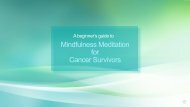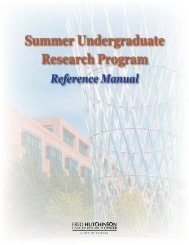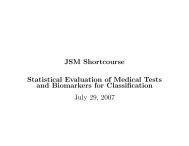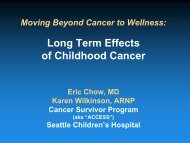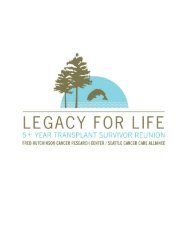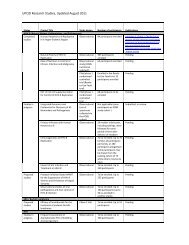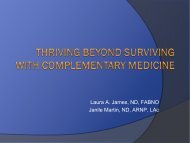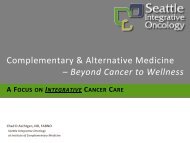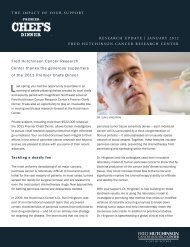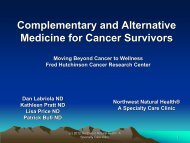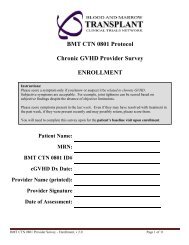Application Instructions - Fred Hutchinson Cancer Research Center
Application Instructions - Fred Hutchinson Cancer Research Center
Application Instructions - Fred Hutchinson Cancer Research Center
Create successful ePaper yourself
Turn your PDF publications into a flip-book with our unique Google optimized e-Paper software.
Exploration Program for Industry Careers 2012-2013<br />
<strong>Application</strong> <strong>Instructions</strong> – Read BEFORE beginning web application<br />
Thank you for your interest in the Exploration Program for Industry Careers (EPIC). All current FHCRC graduate<br />
students, postdoctoral fellows, and medical fellows are eligible to apply. The information provided in your<br />
application will be viewed by participating industry partners when you attend their site visits. Do not include<br />
confidential information in your application.<br />
IMPORTANT: You will not be able to save your progress on the web application. Have your biosketch<br />
completed and ready to copy and paste into the application text box in Section 3 BEFORE beginning the<br />
application process.<br />
Link to web application page:<br />
https://docs.google.com/spreadsheet/viewform?formkey=dFVOcG5RZ1BXdWtmRmt3RkxNZUtoV1E6MA#gid=0<br />
Section 1: Demographic Information<br />
This section is straightforward questions about your current position and background.<br />
You will also be asked your anticipated start date range for an industry job. This is just your best guess, and you<br />
should answer regardless of whether you are committed to pursuing a job in industry or not. Available answers:<br />
Jan-Jun 2013, Jul-Dec 2013, Jan-Jun 2014, Jul-Dec 2014, 2015 or later<br />
Section 2: Interests and Expertise<br />
This section corresponds to a bullet-point list of your relevant interests and skills, and will be presented as such<br />
to the companies whose site visits you attend (see sample at the end of these instructions). In the application<br />
form you will find 3 open slots for each of the categories described below. Have these answers prepared before<br />
starting the application, and check to make sure each answer fits within the limits described below. The<br />
application will not notify you if you exceed a character limit, but your entry may be truncated.<br />
All 4 categories below allow for three entry slots each. It is not required to use every entry slot, but you are<br />
encouraged to use them to highlight your interests, skills, and achievements.<br />
Career Interests - Enter keywords about your industry career interests (job titles, industry sectors, etc). Each<br />
entry should be 1-3 words.<br />
Areas of Expertise - Enter keywords about your current areas of expertise. Each entry should be 1-3 words.<br />
Technical Skills - 95 character limit per skill. This application does not measure character limits, so if you do<br />
not check yourself your skill description may be truncated<br />
Major Accomplishments - Grants, Papers, Patents, etc. 95 character limit each. This application does not<br />
measure character limits, so if you do not check yourself your description may be truncated.<br />
Section 3: Biosketch<br />
1750 character limit, including spaces. Note that the application does not measure character limits, so if you do<br />
not check yourself then your biosketch may be truncated.
Exploration Program for Industry Careers 2012-2013<br />
Your biosketch is one paragraph that should emphasize the most important things you wish to communicate to<br />
the industry partners whose site visits you will be attending. This biosketch is a hybrid between a resume and<br />
cover letter, and thus should include your career interests and motivations as well as key points about your<br />
previous experiences, education, accomplishments and honors.<br />
When you attend a site visit, the host company will see this biosketch paragraph in combination with the<br />
“interests and expertise” that you listed in Section 2. You can see a sample of what this will look like at the end<br />
of these instructions. While you should still stress anything you find especially important, do not be redundant<br />
by simply reiterating all of those same skills and expertise in paragraph form.<br />
This biosketch should be your best professional representation of yourself in this format. We recommend<br />
writing several drafts that you get feedback on before you access the web application to copy and paste in your<br />
final biosketch.<br />
Side note: There is also a mechanism in Section 3 for changing your biosketch in the future, which can be used if<br />
there are significant changes in your accomplishments or interests between now and the site visits. This will<br />
ONLY be allowed for acceptable reasons – not taking the time to create a revised biosketch now during the<br />
application process is NOT significant reason for us to accept a new biosketch from you later this academic year.<br />
The most common reason we foresee for people changing their applications is due to new major<br />
accomplishments (a major paper, grant, patent, etc). You do not NEED to update your application in these cases,<br />
but will be allowed to do so if you want.<br />
EPIC <strong>Application</strong> <strong>Instructions</strong> Addendum - Writing your biosketch<br />
Using the Sample<br />
When filling out your EPIC application, start by looking at the sample provided. This sample illustrates what<br />
companies will see when you attend their site visit. This page is created directly from your responses to the<br />
application questions in the web form. We do not make any additional edits. Some key points to note when<br />
reviewing the sample:<br />
Most of the demographic information you supply in Section 1 of the application will appear in the top<br />
portion of the page.<br />
Section 2 of the application involves bullet-points about your career interests, expertise, technical skills, and<br />
major accomplishments. These will be presented under your main paragraph biosketch, as shown in the<br />
sample.<br />
Section 3 of the application is where you enter the main paragraph, 1750 character limit. This MUST be in<br />
paragraph format, not bullet-points, and should not include info like your name, since that will appear at the<br />
top of the page as shown in the sample. This main paragraph will also appear on the same page as the<br />
accomplishments, skills, etc that you enter in Section 2. It is okay to have a small amount of redundancy<br />
here for key points you want to emphasize. However, consider this final document as one whole piece,<br />
rather than treating the biosketch paragraph and Section 2 bullet points separately. The companies WILL see<br />
them together, as shown in the sample.<br />
NOTE: This should go without saying, but everyone in the program has access to this sample. Your biosketch<br />
should be entirely your own work. Do not reproduce exact phrasing used in the sample. Make your
Exploration Program for Industry Careers 2012-2013<br />
biosketch stand out for the rest in the pile by writing it in your own voice and emphasizing YOUR best<br />
accomplishments and stand-out features early in the paragraph.<br />
Your Biosketch<br />
This program is about careers in the biotech industry, so you should emphasize the same things you would<br />
emphasize in a resume and cover letter if you were applying to a job at this type of company (as opposed to<br />
academia). What are those things? It will depend somewhat on what career path specifically you are interested<br />
in (ie, scientist, project manager, business development, etc). The resources listed at the end of this document<br />
might give you some ideas on what to focus on.<br />
NOTE: If you are still some time away from a job search and are just starting to learn about jobs in industry,<br />
don’t be overly stressed about knowing exactly what to say for an industry job here. One goal of EPIC is to<br />
educate participants about careers in industry, including the best way to “sell yourself” to get them. Make sure<br />
your biosketch is well-written and an accurate reflection of you and your skills/accomplishments/future goals,<br />
but if you don’t know how to stress specific things for industry careers you shouldn’t worry. If, however, you are<br />
indicating that you are entering the job market during the time-frame of the site visits (Jan-Jun 2013) then you<br />
should spend time researching what to put in an industry cover letter/resume compared to academia, and use<br />
what you learn while writing your biosketch and filling out Section 2.<br />
Other things to consider:<br />
When writing your biosketch, think first about what you want the reader to learn about you. What are your<br />
main assets that a company might find attractive, or that make you stand out from other applicants? Highlight<br />
this early in your biosketch.<br />
You do not need to include the name of PIs you worked with in the past, but if you have work experience under<br />
someone with “name power”, you should use it to your advantage.<br />
If you published in a high-profile journal, highlight that accomplishment. Do not, however, give a laundry list of<br />
every publication you have been involved with. That belongs in a CV, not this short biosketch.<br />
Some Additional Resources:<br />
Book: Career Opportunities in Biotechnology and Drug Development, by Toby Freedman<br />
The website for this book has many links to other resources: http://www.careersbiotech.com<br />
Website: The UCSF Office of Career and Professional Development has samples of cover letters and resumes for<br />
both industry and academia: http://career.ucsf.edu/lifesci/samples.job.html<br />
These are just 2 resources that I have looked into and think are useful for this – there are many others out there.<br />
If you find one that you think is particularly helpful, feel free to email them to me (email link below) and I will<br />
compile a more complete list of useful sources at a future date.
Exploration Program for Industry Careers 2012-2013<br />
Final Submission, Confirmation, and Next Steps<br />
Once you hit submit, your application will be uploaded to our database. After the application deadline of Nov<br />
30, all applications will be processed and merged into the template of the sample below. A copy of your<br />
application will be emailed to you at this time for your records. Please allow 2 weeks after the application<br />
deadline for this email to arrive. If you do not receive it by Dec 14, email Shannon Dennis at<br />
smdennis@fhcrc.org.<br />
Site visits will be scheduled for January-June 2013. Once companies and dates are finalized, all applicants will be<br />
invited to RVSP for those visits they wish to attend and are available for. Participants will be selected from the<br />
RSVPs based on the applications submitted in November. Furthermore, the application information of each site<br />
visit attendee will be made available to companies prior to the site visit. This information will be presented<br />
similarly to the sample below. Numbers of applicants and space limitations for site visits will determine how<br />
many site visits each participant is allowed to attend.<br />
If you have questions about any part of the application process or EPIC itself, please contact Shannon Dennis,<br />
EPIC program coordinator at smdennis@fhcrc.org.
Exploration Program for Industry Careers Sample <strong>Application</strong> 2012<br />
Name: Tina Albershardt<br />
FHCRC Division: Human Biology<br />
Position: Postdoctoral Fellow<br />
Predicted Start Date: Jan-Jun 2013<br />
Additional Postdoc Information<br />
Year PhD received: 2010<br />
Graduate Institution: Dartmouth College<br />
Graduate Discipline: Pharmacology &<br />
Toxicology<br />
Graduate PI: Alan Eastman<br />
Email Address: talbersh@fhcrc.org<br />
FHCRC Advisor/PI: Alanna Ruddell<br />
US Citizen/Perm Resident?: Yes<br />
Desired Company Size: Any<br />
Additional Grad Student Information<br />
Date of Entry:<br />
Graduate Institution:<br />
Graduate Program:<br />
Biosketch:<br />
Currently a postdoc with Chris Kemp and Alanna Ruddell at the <strong>Fred</strong> <strong>Hutchinson</strong> <strong>Cancer</strong> <strong>Research</strong> <strong>Center</strong><br />
(FHCRC), I have an extensive background in cancer biology, immunology, and pharmacology. For my<br />
doctoral research in the laboratory of Alan Eastman (Dartmouth Medical School), I studied apoptosis<br />
using human primary leukemia cells and cancer cell lines to determine optimal combinations of small<br />
molecule inhibitors that selectively induce apoptosis in cancer cells but not normal cells. Some of the<br />
combinations from these studies have advanced to clinical trials. During this experience, I learned that<br />
one major hurdle in the field of translational research is the efficient delivery of pharmacologic agents<br />
into the target cells without initiating adverse host immune responses. To further understand the role of<br />
immune cells during cancer development, I thus chose to elucidate B cell-mediated tumor-induced<br />
lymph node lymphangiogenesis and metastasis using mouse models for my postdoctoral research.<br />
Outside the lab, I have held numerous leadership positions, including President of the Graduate Student<br />
Council at Dartmouth College and Co-Chair of the Student/Postdoc Advisory Committee at FHCRC. I have<br />
earned the 2006 Toastmaster of the Year Award (Toastmasters International) and the 2010 Dartmouth<br />
Community Award (Dartmouth College) for my leadership activities. I have also started up a company,<br />
Damarni Solutions, and with my partners, we aim to solve problems that have been overlooked in the<br />
healthcare system (provide website). I would like to participate in EPIC to learn how I can advance my<br />
career in developing novel therapeutics.<br />
Career Interests:<br />
Translational research, Product development, Marketing<br />
Areas of Expertise:<br />
<strong>Cancer</strong> Biology, Immunology, Pharmacology<br />
Technical Skills:<br />
Mouse models of cancer, in vitro and ex vivo manipulation of human and mouse cells<br />
Flow cytometry: multi-color surface and intracellular staining, FACS, FACSDiva and FlowJo<br />
Immunofluorescent staining, ELISA, Western blotting, immunoprecipitation<br />
Major Accomplishments:<br />
Received Ruth L. Kirschstein training grant and published work in peer-reviewed journals<br />
Started a growing biotech company<br />
Recognized nationally for leadership and communication skills



